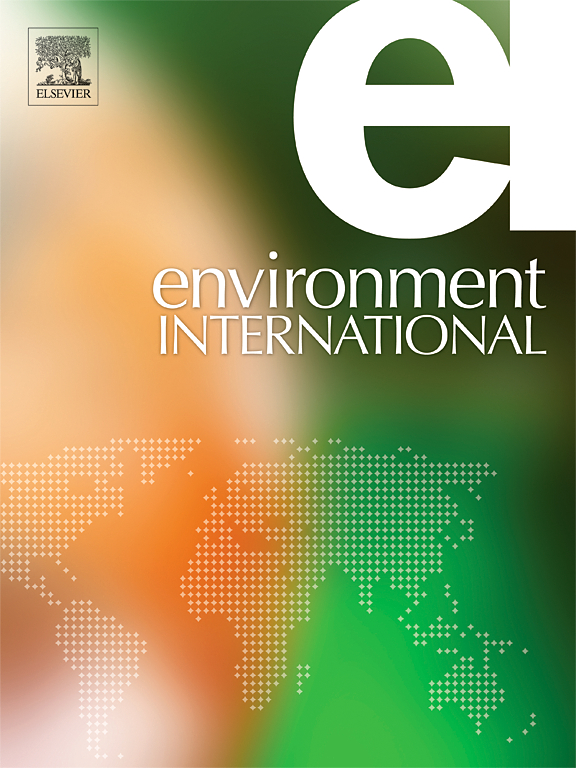儿童早期暴露与健康相关免疫特征
IF 9.7
1区 环境科学与生态学
Q1 ENVIRONMENTAL SCIENCES
引用次数: 0
摘要
早期生活环境暴露被怀疑会改变与儿童健康相关的重要免疫过程。然而,目前还没有研究同时调查暴露体和多个健康领域的免疫毒性。方法:在人类早期生活暴露(HELIX)项目的6个欧洲出生队列的845名儿童(中位年龄8岁)中,我们确定了儿童心脏代谢、呼吸/过敏和神经发育健康评分的免疫特征。这些特征是从血液样本的三个生物层面(白细胞(WBC)组成、血浆蛋白浓度、白细胞的DNA甲基化)中识别出来的,使用的是儿童健康评分监督下的高级析因分析。其次,我们估计了识别的特征与91产前和产后环境暴露之间的关联。ResultsThree关键免疫签名是关联到一个更好的健康儿童得分:第一个蛋白质特征描述低炎症概要(R2 = 17 %),第二个与平衡的抗病毒蛋白特征描述低炎症概要Th响应(R2 = 2 %),白细胞签名描述一个immuno-regulatory和天真的概要文件(R2 = 2 %)。在儿童期,较少接触室内空气污染物、接近蓝色空间和公共交通、健康的饮食习惯和较高的社会资本与健康得分相关的三个免疫特征相关(回归p值 <; 0.05)。从DNA甲基化中发现了一个特征,但与健康评分和暴露量没有显著相关性。结论:这些发现强调了早期生活环境暴露对儿童心脏代谢、呼吸和神经发育健康相关的关键炎症过程的影响。本文章由计算机程序翻译,如有差异,请以英文原文为准。


Early-life exposome and health-related immune signatures in childhood
Background
Early-life environmental exposures are suspected to modify important immune processes related to child health. Yet, no study has investigated immunotoxicity in relation to the exposome and multiple health domains simultaneously.
Methods
Among 845 children (median age 8) from six European birth cohorts included in the Human Early-Life Exposome (HELIX) project, we identified immune signatures of a health score covering cardiometabolic, respiratory/allergic and neurodevelopmental health in children. Those signatures were identified from blood samples in three biological layers (white blood cell (WBC) composition, plasma proteins concentrations, DNA methylation of WBCs) using an advanced factorial analysis supervised on the child health score. Second, we estimated the association between the identified signatures and 91 pre- and postnatal environmental exposures.
Results
Three key immune signatures were associated with a better health score in children: a first protein signature characterizing a low inflammatory profile (R2 = 17 %), a second protein signature characterizing a low inflammatory profile with balanced antiviral Th response (R2 = 2 %), and a WBC signature characterizing an immuno-regulatory and naïve profile (R2 = 2 %). In childhood, less exposure to indoor air pollutants, proximity to blue spaces and public transport, healthy dietary habits and higher social capital were associated with the three immune signatures related to a better health score (regression p-values < 0.05). One signature was identified from DNA methylation, but was not significantly associated with the health score nor with the exposome.
Conclusions
These findings highlight the influence of early-life environmental exposures on key inflammatory processes associated with the cardiometabolic, respiratory and neurodevelopmental health of children.
求助全文
通过发布文献求助,成功后即可免费获取论文全文。
去求助
来源期刊

Environment International
环境科学-环境科学
CiteScore
21.90
自引率
3.40%
发文量
734
审稿时长
2.8 months
期刊介绍:
Environmental Health publishes manuscripts focusing on critical aspects of environmental and occupational medicine, including studies in toxicology and epidemiology, to illuminate the human health implications of exposure to environmental hazards. The journal adopts an open-access model and practices open peer review.
It caters to scientists and practitioners across all environmental science domains, directly or indirectly impacting human health and well-being. With a commitment to enhancing the prevention of environmentally-related health risks, Environmental Health serves as a public health journal for the community and scientists engaged in matters of public health significance concerning the environment.
 求助内容:
求助内容: 应助结果提醒方式:
应助结果提醒方式:


